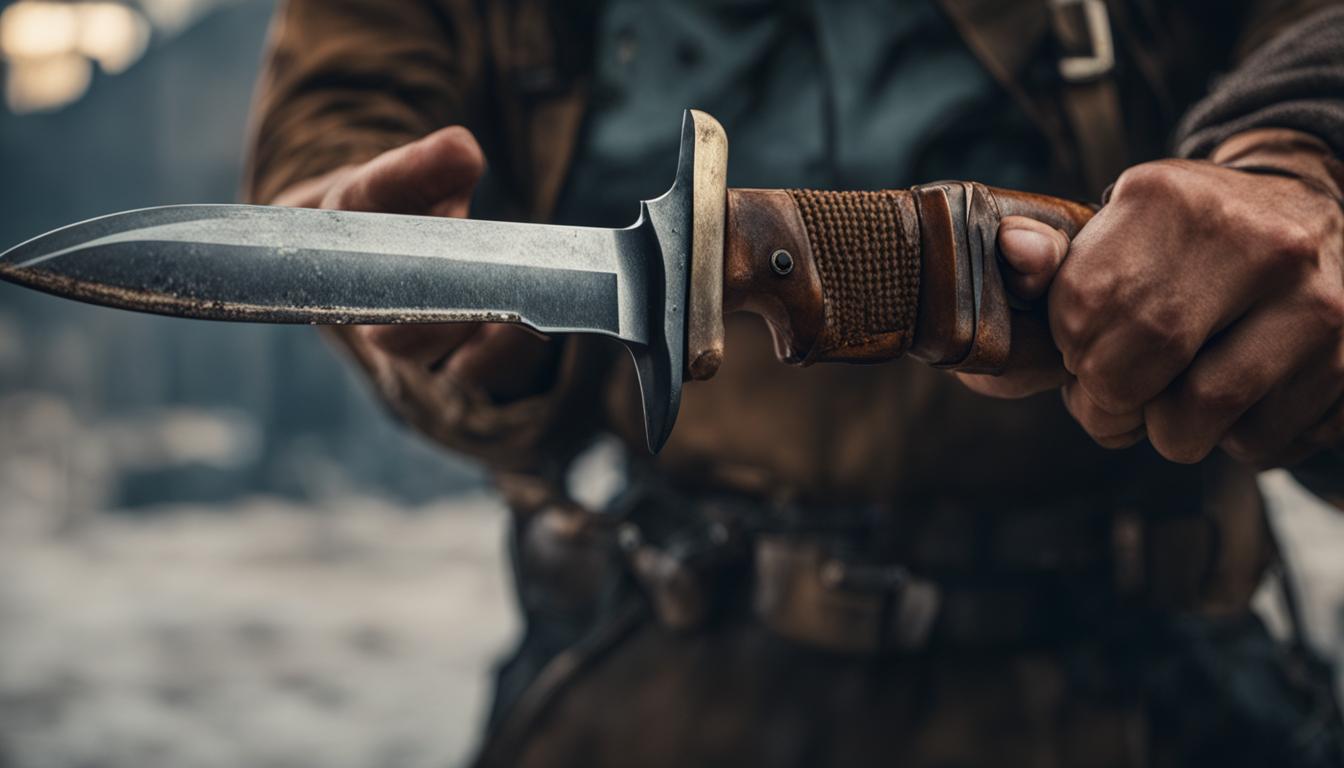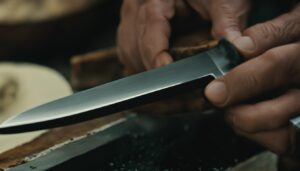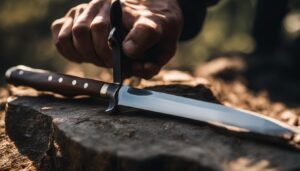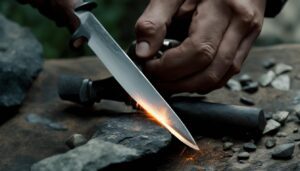When it comes to hunting, having a razor-sharp knife is essential for a successful and efficient experience. However, many hunters unknowingly make mistakes when it comes to knife maintenance, leading to dull blades and frustration. To ensure you avoid these common knife care errors and keep your blade in optimal condition, let’s take a closer look at what mistakes to avoid.
Key Takeaways:
- Starting off with an extremely dull knife hinders progress and makes it difficult to see improvement.
- Not monitoring progress and adjusting techniques can lead to frustration and lack of improvement in sharpening skills.
- Progressing too soon to a finer sharpening medium or starting with too fine a medium can prevent effective sharpening.
- Using too steep of a sharpening angle compromises the knife’s durability and performance.
- To avoid these mistakes, start with a moderately sharp knife, monitor progress, use the appropriate sharpening medium, and maintain the proper sharpening angle.
Importance of Starting with a Moderately Sharp Knife
When it comes to knife maintenance, one common mistake to avoid is starting with an extremely dull knife. Instead, it’s important to begin with a moderately sharp knife for several reasons. First and foremost, starting with a knife that is already fairly sharp allows for quicker progress in sharpening skills. You can more easily monitor your progress and determine what techniques are effective when you’re working with a moderately sharp knife.
Another benefit of sharpening a moderately sharp knife is that it reduces frustration compared to working on an extremely dull knife. Trying to sharpen a knife that is completely blunt can hinder your progress and make it difficult to see any improvement. By starting with a moderately sharp knife, you’ll be able to build confidence and see tangible results.
Maintaining the edge of a moderately sharp knife is also less time-consuming and more rewarding than sharpening a very dull knife. Instead of spending hours trying to restore a completely blunt edge, you can focus on maintaining the sharpness of the knife, which requires less effort and time. This allows you to spend more time enjoying your hunting experience rather than constantly sharpening your knife.
| Starting with an Extremely Dull Knife | Starting with a Moderately Sharp Knife | |
|---|---|---|
| Progress | Difficult to see improvement | Quicker progress in sharpening skills |
| Frustration | Increases frustration | Reduces frustration |
| Time commitment | Time-consuming | Less time-consuming |
Starting with a moderately sharp knife sets a solid foundation for effective knife maintenance and sharpening. It allows you to make progress, monitor your technique, and avoid the frustration that comes with working on an extremely dull knife. By prioritizing the use of a moderately sharp knife, you can optimize your knife maintenance practices and avoid common mistakes that can hinder your hunting experience.
The Importance of Progress Monitoring and Technique Adjustment
When it comes to sharpening knives, progress monitoring and technique adjustment are essential for achieving optimal results. Often, the lack of progress or slow improvement can lead to frustration and hinder the development of effective sharpening skills. Therefore, it is crucial to stick with a consistent sharpening technique and give it time to yield results.
Monitoring progress is key to understanding the effectiveness of your sharpening technique. If you constantly switch techniques without giving them a fair chance, it becomes difficult to determine what works best for your knives. Instead, commit to a particular method and observe how it affects the sharpness and performance of the blade.
Sometimes progress may seem slow, especially when dealing with a dull knife. In such cases, it’s important to exercise patience and avoid overcomplicating the process. Taking a break and returning with the same angle and technique can often help establish an edge without the need for constant modifications.
In summary, to avoid common knife care errors, it’s crucial to monitor progress, stick with a consistent sharpening technique, and exercise patience. By doing so, you can achieve better results and enhance your sharpening skills over time.
The Pitfalls of Progressing Too Soon or Starting with Too Fine a Sharpening Medium
When it comes to sharpening knives, patience and strategy are key. One of the common mistakes to avoid is progressing too quickly from a coarse to a fine sharpening medium. This can prevent the efficient removal of enough steel for proper sharpening. Starting with too fine a sharpening medium can also lead to a polished but dull edge, as the knife may not hold a sharp edge well.
To ensure effective sharpening, it is important to start with a coarse grit or medium that allows for the efficient removal of steel. This lays the foundation for sharpening and refining the edge using finer grits. By understanding the different grits and their functions, hunters can make informed decisions about the appropriate sharpening medium to use.
Avoiding these incorrect knife care methods is crucial for maintaining the performance and longevity of a knife. Starting with a moderately sharp knife, monitoring progress, and using the appropriate sharpening medium are essential steps for successful knife maintenance. By taking the time to sharpen knives properly and avoiding these pitfalls, hunters can ensure their blades are razor-sharp for optimal hunting experiences.
| Incorrect Knife Care Methods | Impact |
|---|---|
| Progressing too soon to a fine sharpening medium | Prevents efficient removal of steel, resulting in ineffective sharpening |
| Starting with too fine a sharpening medium | Leads to a polished but dull edge that doesn’t hold sharpness well |
The Significance of Using the Proper Sharpening Angle
Proper sharpening angle is crucial in achieving a razor-sharp edge and maintaining the performance and longevity of your hunting knife. Choosing the correct angle depends on factors such as the purpose of the knife, the quality of the steel, and personal preference. By understanding the significance of using the proper sharpening angle, you can avoid common knife maintenance blunders and ensure optimal cutting performance.
When sharpening your knife, holding a shallower angle can result in better cutting performance, but it may sacrifice edge longevity. On the other hand, a steeper angle can produce a more durable edge but may compromise the knife’s cutting ability. It’s essential to find the right balance that works best for your specific knife and its intended use.
Experimentation and practice are key in determining the ideal sharpening angle for your knife. Start by testing different angles and observing the results. Take note of the blade’s sharpness, the ease of cutting, and how long the edge holds up during use. Adjust the sharpening angle accordingly to achieve the desired balance between cutting performance and edge durability.
Proper sharpening angle is the secret to a razor-sharp hunting knife. Finding the right balance between cutting performance and edge longevity is essential for optimal results.
Remember, using the proper sharpening angle is just one aspect of knife maintenance. It is essential to combine it with other correct knife care methods to ensure your hunting knife is in top condition for your next outdoor adventure.
Tips for Using the Proper Sharpening Angle:
- Invest in a sharpening guide or angle guide to help maintain a consistent angle throughout the sharpening process.
- Practice maintaining the proper angle by using visual aids such as pennies or folded paper to ensure consistency.
- Take your time and make deliberate, controlled strokes while maintaining the sharpening angle to avoid mistakes and achieve an even edge.
By mastering the proper sharpening angle and combining it with other effective knife care methods, you can ensure your hunting knife remains sharp, reliable, and ready for any outdoor challenge.
Tips and Techniques for Sharpening Knives
When it comes to maintaining a sharp and reliable cutting edge on your hunting knife, there are several essential tips and techniques to keep in mind. By following these guidelines, you can avoid common knife care errors and ensure that your knife is always ready for action.
1. Use the Right Tools for the Job
One of the key aspects of knife sharpening is utilizing the correct tools. Consider investing in a high-quality sharpening stone or honing rod, as these tools are specifically designed for sharpening knives. Avoid makeshift methods or using the wrong tools, as they can lead to ineffective sharpening and potential damage to the blade.
2. Maintain a Consistent Sharpening Angle
The sharpening angle plays a crucial role in the overall performance and longevity of your knife’s edge. It’s essential to maintain a consistent angle throughout the sharpening process to achieve a sharp and durable edge. Using tools such as pennies or folded paper can help you maintain the desired angle and ensure a consistent result.
3. Practice Patience and Consistency
Sharpening a knife is a skill that requires practice and patience. Take your time and be consistent with your sharpening technique. Avoid rushing through the process or making drastic changes in technique if progress seems slow. Stick with a consistent method, monitor your progress, and make subtle adjustments as needed. Remember, practice makes perfect!
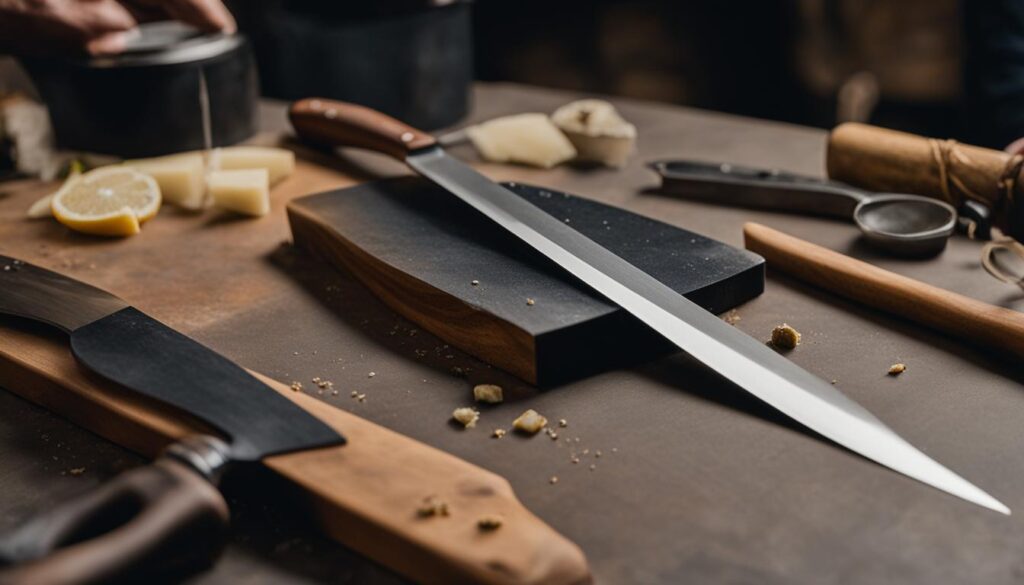
By following these knife sharpening tips and techniques, you can avoid common knife care mistakes and ensure that your hunting knife is always in its best condition. Remember to use the right tools, maintain a consistent sharpening angle, and practice patience and consistency. With proper maintenance, your knife will provide you with a razor-sharp edge for many hunting adventures to come.
Conclusion
Proper knife maintenance and sharpening techniques are essential for maintaining a sharp and safe cutting edge. By avoiding common knife maintenance mistakes, such as starting with an extremely dull knife and not monitoring progress, hunters can greatly improve their sharpening skills. Progressing too quickly and using improper sharpening angles can also hinder the effectiveness of knife maintenance.
To optimize your knife maintenance practices and enhance your overall hunting experience, it is important to start with a moderately sharp knife. This allows for quicker progress and easier monitoring of your sharpening techniques. Additionally, using the appropriate sharpening medium and maintaining the proper sharpening angle are crucial for achieving desired results.
Remember, patience and perseverance are key when it comes to sharpening knives and avoiding common mistakes. By following these guidelines and implementing proper knife maintenance practices, you can ensure your knife stays razor-sharp and ready for your next hunting adventure.
FAQ
What are some common knife maintenance mistakes to avoid?
Some common knife maintenance mistakes to avoid include starting off with an extremely dull knife, not monitoring progress, progressing too quickly, and using improper sharpening angles.
Why is it important to start with a moderately sharp knife?
Starting with a moderately sharp knife allows for quicker progress in sharpening skills, makes it easier to monitor progress, reduces frustration compared to working on an extremely dull knife, and is less time-consuming to maintain.
How can I monitor progress and adjust my sharpening technique?
Monitoring progress involves regularly checking the sharpness of the knife’s edge and making adjustments as needed, such as correcting the sharpening angle. This helps ensure better results and improved sharpening skills.
What are the pitfalls of progressing too soon or starting with too fine a sharpening medium?
Progressing too soon to a finer sharpening medium or starting with too fine a medium can prevent the removal of enough steel for effective sharpening. This can result in a polished but dull edge that doesn’t hold sharpness well.
Why is the proper sharpening angle significant?
The proper sharpening angle plays a crucial role in the performance and longevity of the knife’s edge. Factors such as the purpose of the knife, the quality of the steel, and personal preference should be considered when determining the proper angle.
What are some tips and techniques for sharpening knives?
Some tips and techniques for sharpening knives include using tools to maintain a consistent sharpening angle, utilizing a back-and-forth motion using the entire length of the sharpening stone, and applying permanent marker to visualize where steel is being removed and where adjustments are needed.
